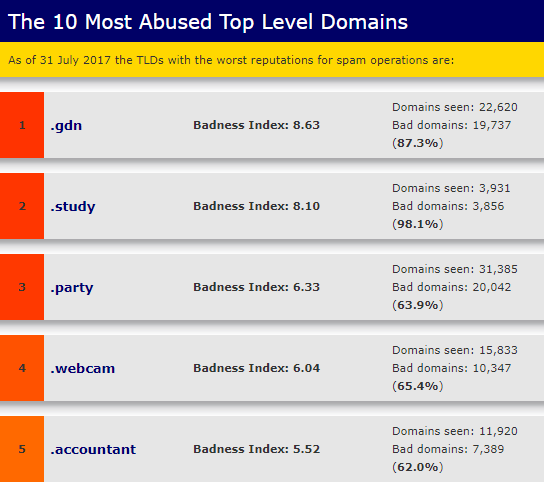Before 1983, visiting a host on a network required typing in its IP address. The fledgling internet was much smaller, and reaching individual sites was only possible if you knew where to look. Fortunately, the Internet Engineering Task Force introduced their pioneering Domain Name System (DNS), allowing numerical IP addresses to be identified as specific domain names.
Instead of having to remember a long sequence of numbers, like 69.171.234.21, you only have to remember a URL: Facebook.com.
Along with the new DNS, domain extensions appeared. A domain extension is the top-level part of the domain name (TLD), such as .com, or .net. A majority of sites use .com, making it easy to forget that at their inception, each domain extension had a specific intended purpose. Well, that rings true today, even though the lines have been somewhat blurred. That said, there are a significant number of TLDs used for their specific purpose -- and that alone.
Let's take a short walk through the history of domain extensions, and look at where we are today.
History of Domain Extensions
In 1984, the Internet Assigned Numbers Authority (IANA) established the first six domain extensions: .com, .edu, .gov, .mil, .org, and .net. Shortly after, the first two-character country code domain extensions (like .uk and .us) were established. In 1988, .int was also introduced.
After that, the internet exploded into life (not as a direct result of the TLDs, I must add, but it certainly made browsing the internet much easier). But it wasn't until after the Internet Corporation for Assigned Names and Numbers (ICANN) was created in 1998 that any new domain extensions (besides country code extensions) came into use.
At the time, ICANN had an agreement with the United States Department of Commerce to operate IANA. However, a number of countries asserted that dominance over those organizations essentially established the U.S. as the de facto "leaders" of the internet. Moreover, the U.S. authorities actually agreed and, on October 1st 2016, transferred power of ICANN to a multi-stakeholder community comprising of member nations.
Types of Domain Extensions
For a long time, there were only the aforementioned Generic Top Level Domains (gTLDs). A gTLD is now considered anything unsponsored e.g. is not limited by geography, industry, country designation, etc.
In 2000, a selection of seven new TLDs became available: .aero, .biz, .coop, .info, .museum, .name, and .pro.
ICANN added further TLDs throughout 2005, up to 2007, including .cat, .jobs, .mobi, .tel, .travel, and .asia. This batch were sponsored TLDs, serving a specific community, whether that be geographic, ethnic, professional, technical, or other.
In 2008, the adherence to the existing TLD system began to change. ICANN initiated a new TLD naming process that aimed to take "a significant step forward on the introduction of new generic top-level domains."
This momentous development fundamentally changed the TLD system. Previously, there were only 22 gTLDs available, and domains registered had to use Latin characters (or over 280 including two-letter country codes). Suddenly, it became possible for anyone with enough money to apply for a gTLD. Furthermore, non-Latin characters, such as Cyrillic, Arabic, and Chinese, could feature as gTLDs.
Where previously a gTLD was almost exclusively defined by one organization, businesses could create an arbitrary gTLD matching their company branding. The ICANN Statutory Application Fee for a gTLD currently stands at $185,000. (This is before paying an annual global registration fee -- you have to pay for your blog hosting ever year, and this is no different.)
New Application Period
But before you and Dave from the pub get any ideas, not just anyone can start a gTLD. It must come from an established organization or company, and the process takes a minimum of nine months, and that is without hitting any snags on the way. If yours and Dave's application gets pushed to an extended evaluation requiring arbitration from the Registry Services Technical Evaluation Panel, you'd better ask Steve if he's got an extra $50,000 laying around, because it is immediately added to your receipt. That vanity URL is really going to set you back...
Of course, $185,000 isn't that much, especially for major corporations. ICANN opened their newly devised gTLD application system in 2012, receiving over 1,900 applications -- over 750 of which were contested between two or more parties. And, as you'd expect, big companies took the chance to ensure brand protection. For instance, Microsoft applied for:
- AZURE
- BING
- DOCS
- HOTMAIL
- LIVE
- MICROSOFT
- OFFICE
- SKYDRIVE
- SKYPE
- WINDOWS
- XBOX
And while Apple applied for only one (.apple), Amazon and Google applied for 76 and 101 gTLDs, respectively.
Remember the $185,000 cost for a gTLD? That is if there are no contentions, and your application process is the smoothest. Amazon ended up forking out over $4.5 million for the .buy gTLD ICANN public auction. Google splashed a cool $25,000,001 on the .app gTLD at the same auction.
Restricted or Unrestricted
All domain extensions are either restricted or unrestricted. A sponsored TLD is almost always restricted.
For example, only accredited educational institutions are eligible to register a domain with a .edu extension. Many country code domain extensions are also restricted and can only be registered by citizens or residents of the country that the extension refers to.
.aero, sponsored by private air transport communications company, SITA, limits registration to air transport companies.
Conversely, unrestricted domain extensions, like .com, .org, and .net, can be registered by anyone. There are also some unrestricted country code domain extensions, which has resulted in the registration of "domain hacks" that create a word using the domain extension. Del.icio.us, for example, uses the United States country code .us to form the word "delicious."
Wikipedia keep an up-to-date List of Internet top-level domains.
Modern Domain Extensions
New domain extensions are constantly proposed and debated. As with most things in life, it really depends how much money is behind the debate team. Hence, we have .horse, .sucks, .webcam, and more. That said, we also have .xyz, and Google parent company Alphabet decided it was good enough for their site.
In addition, it may come as no surprise to learn that many new domain extensions become flooded with "bad domains," pumping out spam mail and other nasties. Domain extension owners desperate to make a return on their investment knowingly allow the abuse of their domains, and we suffer the consequences.
And, in reality, how often do you notice the domain extension you're using, anyway?
Are there any domain extensions you really would like to see? Or do you think it is just a waste of time, and a shameless money-grab by ICANN? What would your domain extension be? Let us know your thoughts in the comments below!




